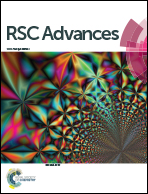Removal of perchlorate from water using a biofilm magnetic ion exchange resin: feasibility and effects of dissolved oxygen, pH and competing ions
Abstract
A biofilm magnetic ion exchange (BMIEX) resin was obtained by mixing a magnetic ion exchange (MIEX) resin with perchlorate-acclimated cultures. Four-cycle batch tests using the BMIEX resin, virgin MIEX resin and cultures of perchlorate-reducing bacteria (PRB) were performed to investigate the feasibility and performance of the BMIEX resin in removing perchlorate (ClO4−). This novel approach can achieve efficient simultaneous perchlorate adsorption and reduction through biofilm formation on the MIEX resin. Moreover, the effects of dissolved oxygen (DO), pH and common coexisting ions (NO3− and Cl−) on the BMIEX process were investigated to optimize perchlorate removal using BMIEX resin. Excellent perchlorate removal only occurred under anaerobic conditions, and a DO concentration of 2.07 mg L−1 was sufficient to inhibit perchlorate removal by the BMIEX resin. A neutral pH range was optimal, and maximum perchlorate removal was obtained at pH 6.8. The presence of NO3− or Cl− could adversely affect perchlorate reduction, and the inhibition of nitrate was substantially stronger than that of chloride. Increasing nitrate concentrations significantly inhibited the perchlorate removal efficiency of the BMIEX process. Community analysis of the biofilm revealed α-, β-, γ- and δ-Proteobacteria as the main PRB, accounting for approximately 21.04%, 12.44%, 24.33% and 0.71%, respectively.


 Please wait while we load your content...
Please wait while we load your content...